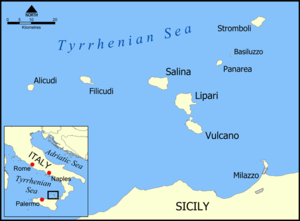Battle of Mylae
| Battle of Mylae | |||||||
|---|---|---|---|---|---|---|---|
| Part of the First Punic War | |||||||
 Location of Mylae (Milazzo) on the coast of northern Sicily |
|||||||
|
|||||||
| Belligerents | |||||||
| Roman Republic | Carthage | ||||||
| Commanders and leaders | |||||||
| Gaius Duilius | Hannibal Gisco | ||||||
| Strength | |||||||
| 90 ships | 130 ships | ||||||
| Casualties and losses | |||||||
| 11 ships | 50 ships | ||||||
The Battle of Mylae took place in 260 BC during the First Punic War and was the first real naval battle between Carthage and the Roman Republic. This battle was key in the Roman victory of Mylae (present-day Milazzo) as well as Sicily itself. It also marked Rome's first naval triumph and also the first use of the corvus in battle.
Inspired by success in the battle of Agrigentum, the Romans sought to win all of Sicily, but required naval power to do so. In order to challenge the already prominent Carthaginian naval forces, Rome built a fleet of one hundred quinqueremes and twenty triremes. The famous Greek historian Polybius wrote that Rome used a wrecked Carthaginian quinquereme captured at Messina as a model for the entire fleet, and that the Romans would have otherwise had no basis for design. However, this may have been an exaggeration, as the Romans had also borrowed Greek quinqueremes previously in 264.
Rome’s two consuls of 260 were Gnaeus Cornelius Scipio Asina and Gaius Duilius. It had been decided that the former would handle the fleet and that Duilius would command the army. However, Scipio’s first encounter with the enemy in the Battle of the Lipari Islands led to the loss of 17 ships and an embarrassing surrender to the Carthaginians under the general Senator Boodes and the naval commander Hannibal Gisco. This was the same Hannibal who had retreated after the conquest of Agrigentum, but not the famous Hannibal who would much later invade Italy during the Second Punic War. After Scipio Asina's surrender, the remaining fleet was placed in the hands of Duilius, and the foot soldiers were turned over to military tribunes.
The Romans recognized their weakness in naval power and tactics, especially after the incident of the Lipari Islands. With this in mind they constructed the corvus, a plank to link ships together at sea. The inventor of the corvus is unknown, but it could have been a Syracusan, such as Archimedes. This device would be attached to the prow of Roman ships on a rotating axle, so that it could be swung around; and its spiked end could then be dropped onto an enemy ship. In this way the Romans could still make use of their superior soldiers by loading them across the corvus and onto enemy ships.
...
Wikipedia
